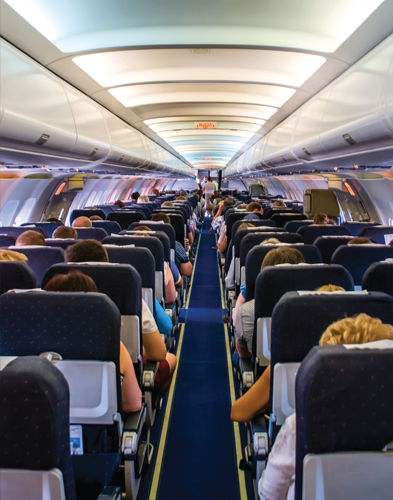Risk management, compliance and safety intelligence are intrinsically linked with aviation insurance. Find out how these crucial elements work together to keep AIG ahead of the underwriting market.

The aviation insurance industry demonstrated profitability over the years spanning the early part of this decade, driven from the 09/11 rating environment. Behind this was the airline industry’s sterling safety record, which had been driven by a combination of technological and managerial improvements across the globe. The high cost of oil had boosted the introduction of a new generation of fuel‑efficient aircraft, while a proactive and systematic analysis of safety trends had dramatically improved risk mitigation within airlines – 2012 was so far, according to IATA, the best year in the history of aviation safety with one accident every five million flights.
However, 2013 was the year that marked a turning point, as market conditions started to deteriorate. This was not because of an exceptional increase in major loss events, but following years of continuous reductions, premiums had just become too low in the face of any loss against attritional claims and with the backdrop of marketplace commoditisation. With market mutualisation a distant memory and an increase in insurer capacity, prices continued to drop.
Looking forward, exposures will inevitably continue to rise with increased hull values, especially with the introduction of difficult and expensive to repair composite materials. Recent industry analysis suggests that although we are seeing fewer major events due to the overall improving technology in the industry, the per‑hull cost of repair for a composite airliner versus similar structural damage to an alloy aircraft is four to six times greater. This data is based on a relatively short time span (three years), given the relative infancy of composite fleets, but the potential impact to an insurer is clear.
Other factors that are likely to change the claims picture are the emergence of a more litigious judicial system, characterised by a rise in class actions and an increase in the size of liability settlements, as well as a sharp increase in the number of flights and passenger movements. The Boeing 2017 Market Outlook predicts passenger numbers to increase by 4.7% per year over the next 20 years (based on revenue passenger kilometres (RPK)). This growth will be supported by an additional 40,000 new aircraft deliveries through to 2036. At the same time, consolidation amongst airlines will tend to reduce premiums further. In the absence of evasive action, the market is heading for a crash.
Avoidinga collision
Albert Einstein is sometimes quoted saying: The definition of insanity is doing the same thing over and over again and expecting a different result. Put bluntly, that is what the aviation insurance industry has been doing. But there are signs that this insanity is about to come to an end. There is no magic recipe for turnaround, but risk selection and adherence to underwriting discipline will most probably be key factors of success in both the insurance and reinsurance markets. Insurers will have to learn to say "no” again, and look to protect their bottom line with underwriting discipline. In addition, cost control will inevitably increase as margins reduce.
This needs to be done while paying close attention to service, as insurers need to recognise that clients now have a wider choice of options when deciding on the signing of their policies as insurance is effectively a service industry. To avoid the further commoditisation of their product, insurers will have to move the discussion with clients away from one which is focused solely on price to emphasise the other benefits they can offer, such as superior claims handling, client risk solutions, industry expertise and underwriting excellence.
Innovation will also represent a key to success. The aviation industry has seen spectacular technical and commercial progress over the years. Insurance must embrace that trend.
Moving the needle
A number of insurers have already made significant investments in order to differentiate their offering to the market and provide more holistic solutions, as they position themselves to aviation insurance buyers as strategic partners in managing their operational risks.
Some insurers, such as AIG, now offer safety consulting and data services in partnership with specialist risk management consultants who provide a full range of innovative, state‑of‑the‑art loss control tools.
With the regulatory environment constantly changing, compliance is a key issue. In addition, robust risk management programmes need to be adopted by all clients whatever their size of business. Buyers should expect a comprehensive onsite audit to verify that their operation complies with the International Standard for Business Aviation (IS‑BAO) protocols toward their certification. This would include a gap analysis of their systems, policies, processes and procedures, either onsite or remotely.
Other important tools include safety intelligence reports and pilot and aircraft safety surveys. Insurers can offer access to the largest, most up‑to‑date database of charter operators, pilots and aircraft, allowing airlines to create due‑diligence reports for every flight against their company’s safety standard, with gap analyses used for actuarial study. Underwriters themselves need to stay on top of market developments, a responsibility made easier by various market publications and social media channels covering the aviation industry in more detail than ever. The onus is also on clients to ensure their employees are aware of these market developments.
Insurers can also provide customised safety and risk management training courses for employees at every level of the organisation on a variety of leading‑edge safety topics.
Simply put, it is probable that those insurers who are not prepared to adapt and who simply wait for a hypothetical market turn are likely to face turbulent times. The focus has to be on sustainability and thus profitability rather than top line growth. In the same way that the aviation industry has made constant and successful efforts to improve safety to an unprecedented level, so insurers must pay them the compliment of showing the same dedication, underwriting discipline and imagination.
By Mark Sperring, AIG
By Mark Sperring, AIG



